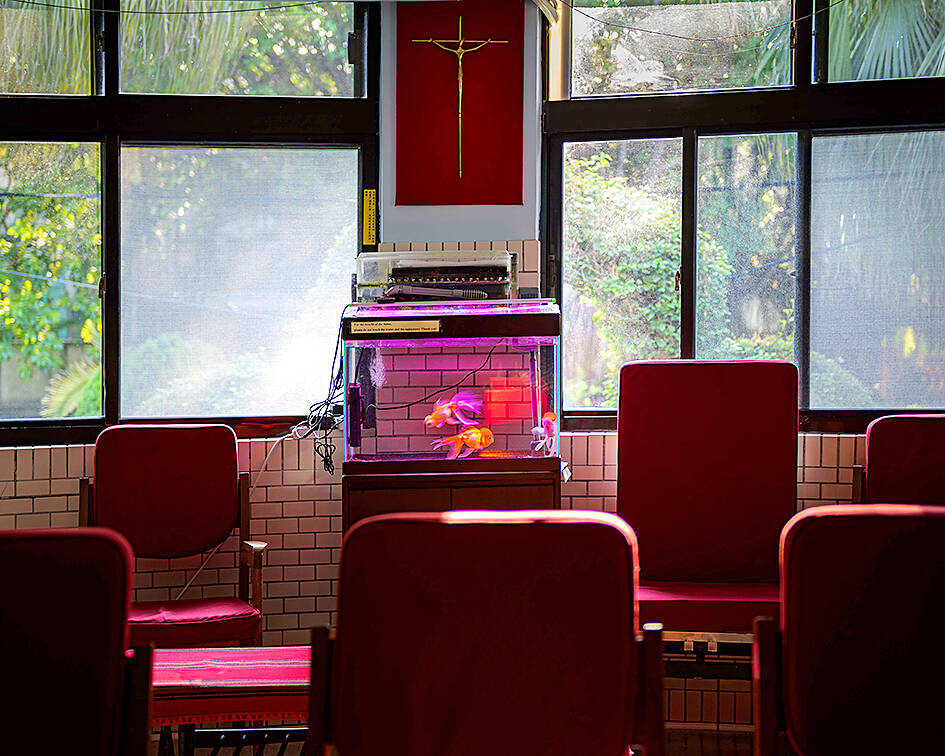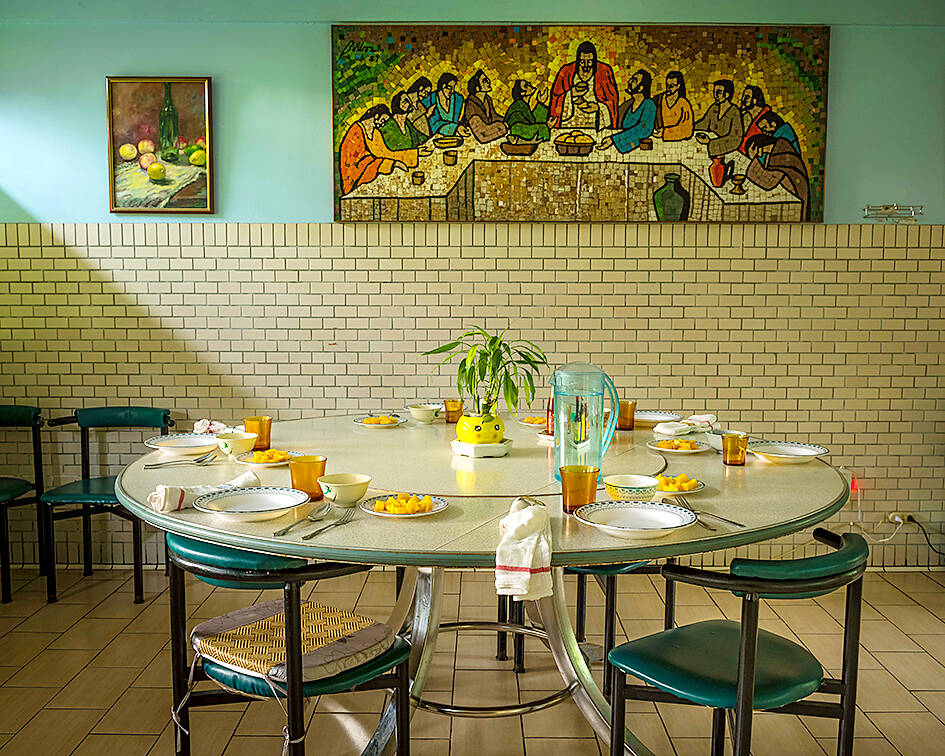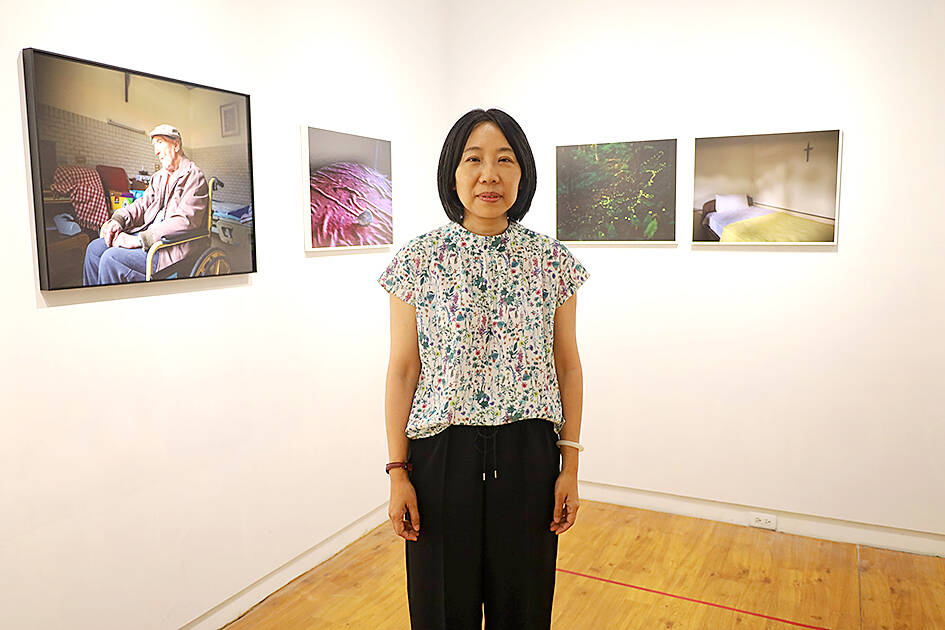In 2017, Chuang Ying-chih (莊?智) emerged onto the Taipei art scene with A Topographical Tale of Ximending, a photo series that documented marginalized communities living in Taipei’s Wanhua District (萬華).
The artworks won a number of awards including the Special Jury Award at the 2017 Young Art Taipei Contemporary Art Fair.
This month, she’s back with an equally stirring photo series A Time to Scatter Stones, which is currently on view at 1839 Contemporary Art Gallery (1839當代).
Photo courtesy of Chuang Ying-chih
As with her previous work, Chuang continues to study unique worlds. This time, however, she’s not capturing the “emotions of fading subcultures” but a sense of “waiting” in the St. Joseph Garden (頤福園), a residential care facility in New Taipei City (新北市) that is home to 10 priests at any given time, most of who are 90 years old, have lived in Taiwan for decades and have chosen to remain here “for the final chapters of their lives,” she tells the Taipei Times.
The images captured over a period of two years (2018-2020) reveal a strange and pious world where priests of the Society of Jesus originally from far-flung places such as Canada, France and Latin America live out their last days in quiet isolation.
THE LIVES OF OTHERS

Photo courtesy of Chuang Ying-chih
Chuang encountered photography while studying for a PhD in the US, but it was only after some professors invited her to join a group project documenting the fading culture of East Palo Alto — a city between San Francisco and San Jose that was being gentrified — that Chuang discovered the medium’s power.
“The area was mostly blue collar and multicultural but commercial interests were moving in,” she says.
The documentary project has inspired her artwork since.

Photo courtesy of Chuang Ying-chih
Back in Taiwan, Chuang says she was too busy to commit to the life of an artist, but eventually wound up taking classes at National Taiwan University of Arts (國立臺灣藝術大學), where students were asked to make a community photo project.
Channeling her experience in the US, Chuang set out to Taipei’s Ximending in search of inspiration.
“I entered the private spaces of different subculture groups — gay saunas, massage houses and karaoke bars.”

Photo: Thomas Bird, Taipei Times
The images reveal lives lived in the shadows — the places inhabited by those on the very edge of society.
“I think that’s when I started to take art seriously,” she says.
STAGE OF LIFE EXPERIENCE

Photo courtesy of Chuang Ying-chih
Having established herself as a photographer with an eye for left-of-field concerns, Chuang next found inspiration at St. Christopher’s Church (聖多福天主堂).
Chuang says that her work at Taipei Medical University requires a lot of walking around Taipei, and that’s how she met a nun for the church, who would later invite her to take photos of where the nuns lived.
From there, the they introduced Chuang to the priest’s retirement center.
“They said it was a unique place.”
As with Ximending, Chuang discovered in St. Joseph Garden a world obscured from the mainstream gaze.
She then “embedded” herself in their world and would frequently visit “to help them if they had some rituals or holidays,” all the while, taking pictures.
The images reveal a curious blend of east and west — a religious effigy in a banyan tree; Christmas lights decorating a classical ink painting.
At the same time, Chuang’s father was suffering from dementia. She began to see her family circumstance mirrored in what she was witnessing in the care home.
“It’s a stage of life experience,” she says of the final phase of the human experience she sought to capture.
She said that during the two years she photographed there, many priests passed away, while she was going through many personal changes.
“I felt like I was in a state of dissociation, mentally, physically and socially,” she says. “These photographs are the recollection of the time the priests and I spent together in waiting.”

In the March 9 edition of the Taipei Times a piece by Ninon Godefroy ran with the headine “The quiet, gentle rhythm of Taiwan.” It started with the line “Taiwan is a small, humble place. There is no Eiffel Tower, no pyramids — no singular attraction that draws the world’s attention.” I laughed out loud at that. This was out of no disrespect for the author or the piece, which made some interesting analogies and good points about how both Din Tai Fung’s and Taiwan Semiconductor Manufacturing Co’s (TSMC, 台積電) meticulous attention to detail and quality are not quite up to

April 21 to April 27 Hsieh Er’s (謝娥) political fortunes were rising fast after she got out of jail and joined the Chinese Nationalist Party (KMT) in December 1945. Not only did she hold key positions in various committees, she was elected the only woman on the Taipei City Council and headed to Nanjing in 1946 as the sole Taiwanese female representative to the National Constituent Assembly. With the support of first lady Soong May-ling (宋美齡), she started the Taipei Women’s Association and Taiwan Provincial Women’s Association, where she

Chinese Nationalist Party (KMT) Chairman Eric Chu (朱立倫) hatched a bold plan to charge forward and seize the initiative when he held a protest in front of the Taipei City Prosecutors’ Office. Though risky, because illegal, its success would help tackle at least six problems facing both himself and the KMT. What he did not see coming was Taipei Mayor Chiang Wan-an (將萬安) tripping him up out of the gate. In spite of Chu being the most consequential and successful KMT chairman since the early 2010s — arguably saving the party from financial ruin and restoring its electoral viability —

It is one of the more remarkable facts of Taiwan history that it was never occupied or claimed by any of the numerous kingdoms of southern China — Han or otherwise — that lay just across the water from it. None of their brilliant ministers ever discovered that Taiwan was a “core interest” of the state whose annexation was “inevitable.” As Paul Kua notes in an excellent monograph laying out how the Portuguese gave Taiwan the name “Formosa,” the first Europeans to express an interest in occupying Taiwan were the Spanish. Tonio Andrade in his seminal work, How Taiwan Became Chinese,